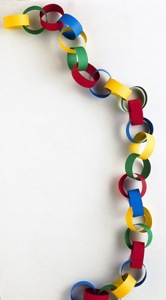Paper Chains to Help Young Children Who Stutter Prepare For Transition
 |
About the presenter: Vanessa Sacchi M.A., CCC-SLP received her Undergraduate Degree with honors from the University of Vermont where she did a research study with Dr. Barry Guitar PhD., CCC-SLP about preschoolers who stutter. Then received her Master's Degree from the University of Colorado-Boulder. An internalized person who stutters, Vanessa is now helping others become empowered by gaining control over their stuttering at the Boulder and Denver offices for The Center for Stuttering Therapy. |
Paper Chains to Help Young Children who Stutter Prepare for Transition
by Vanessa Sacchi
from Colorado, USA
The advent of school, an upcoming vacation, moving to a new house, or holidays all can be exciting times in the lives of children who stutter. These changes, transitions, or milestones can be difficult for kids who stutter, and as a result can significantly impact their level of fluency. Creating a paper chain is an  excellent way to provide children with a visual reminder, and also an opportunity to discuss their feelings about the upcoming event in their life.
excellent way to provide children with a visual reminder, and also an opportunity to discuss their feelings about the upcoming event in their life.
It is best to create the paper chain two weeks before the event occurs. The paper chain can be placed in the child's room, or hung above the child's bed. Each night, as the parent and child say goodnight, they remove one of the rings from the paper chain. They then count the remaining rings, as they represent the number of days left before the anticipated event occurs. Parent and child then take this ritual one step further, and each night they discuss a different emotion that the child may be feeling because of the event. The first night, they take turns and discuss things that they are excited about associated with the event. On the subsequent nights, they discuss things that they are happy about, worried or concerned about.
Our parents, at The Center for Stuttering Therapy, are encouraged to model "easy talk" while they do this routine with the child each night. The parent is not allowed to prompt the child to use "easy talk". Parents are not allowed to prompt during this time because we want the child to feel that their parent is paying full attention to what they are saying, and that the parent is not distracted by how they are conveying their message (with or without the use of techniques). Modeling easy talk during this time gives children the opportunity to choose to use "easy talk" on their own volition. This routine provides children a venue to discuss their feelings, and the time to fully process the range of emotions they may be feeling with any upcoming event or transition in their life.
Many of our parents at the Center for Stuttering Therapy used this strategy during the advent of the new school year. All of our parents were very happy with the information that they gleaned from their children during this set time. Children shared valuable information with their parents, such as being excited about having a new playground, being happy and worried about getting hot lunch for the first time, and concerns about having more than one teacher during a school day. Knowing this information allowed parents to quell fears, and boost their child's confidence in being able to handle these novel situations successfully. Additionally, many of our kids who used the paper chain this year had much greater stability in regard to their fluency than they had experienced in prior years.
SUBMITTED: September 3, 2009

